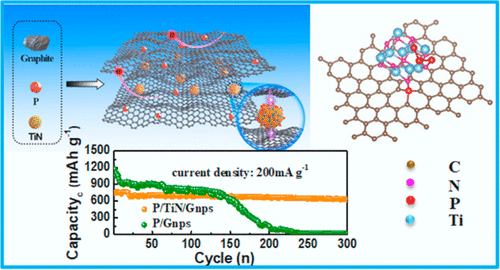Our official English website, www.x-mol.net, welcomes your feedback! (Note: you will need to create a separate account there.)
Three-Dimensional Electronic Network Assisted by TiN Conductive Pillars and Chemical Adsorption to Boost the Electrochemical Performance of Red Phosphorus.
ACS Nano ( IF 17.1 ) Pub Date : 2020-03-31 , DOI: 10.1021/acsnano.0c00216 Weijie Li 1 , Chao Han 1, 2 , Qinfen Gu 3 , Shulei Chou 1 , Hua Kun Liu 1 , Shi Xue Dou 1
ACS Nano ( IF 17.1 ) Pub Date : 2020-03-31 , DOI: 10.1021/acsnano.0c00216 Weijie Li 1 , Chao Han 1, 2 , Qinfen Gu 3 , Shulei Chou 1 , Hua Kun Liu 1 , Shi Xue Dou 1
Affiliation

|
The practical application of red phosphorus (P) for sodium-ion batteries (SIBs) is retarded by its poor reversibility and its unstable cycling life derived from its poor conductivity and huge volume expansion. Graphene is considered as an ideal matrix to remedy these weaknesses due to its excellent conductivity and two-dimensional structure. Its π-π restacking causes spatial collapse, however, meaning that graphene cannot effectively buffer volume expansion. Herein, multifunctional TiN is introduced into a P composite to fix this issue. TiN acts as conductive pillars, electron transfer bridges, and a chemical adsorbent of phosphorus in the composite, to prevent the graphene nanoplates from restacking, to bridge gaps between the graphene nanoplates, and to chemically adsorb the P, resulting in the formation of a three-dimensional electronic network and endowing the pulverized P particles with good contact with the conductive matrix to avoid forming insulating "dead P". Consequently, the P composite presents excellent performance for SIBs.
中文翻译:

TiN导电柱和化学吸附辅助的三维电子网络,可增强红磷的电化学性能。
红磷(P)在钠离子电池(SIB)中的实际应用由于其差的可逆性以及由于其差的电导率和巨大的体积膨胀而导致的不稳定的循环寿命而受到阻碍。石墨烯因其出色的导电性和二维结构而被认为是解决这些缺点的理想基质。其π-π重堆积会导致空间塌陷,但是,这意味着石墨烯无法有效地缓冲体积膨胀。在此,将多功能TiN引入P复合材料以解决此问题。TiN充当复合材料中的导电柱,电子传输桥和磷的化学吸附剂,以防止石墨烯纳米板重新堆积,桥接石墨烯纳米板之间的间隙并化学吸附P,这样就形成了三维电子网络,并使粉状的P颗粒与导电基体良好接触,从而避免形成绝缘的“死P”。因此,P复合材料对SIB具有优异的性能。
更新日期:2020-03-31
中文翻译:

TiN导电柱和化学吸附辅助的三维电子网络,可增强红磷的电化学性能。
红磷(P)在钠离子电池(SIB)中的实际应用由于其差的可逆性以及由于其差的电导率和巨大的体积膨胀而导致的不稳定的循环寿命而受到阻碍。石墨烯因其出色的导电性和二维结构而被认为是解决这些缺点的理想基质。其π-π重堆积会导致空间塌陷,但是,这意味着石墨烯无法有效地缓冲体积膨胀。在此,将多功能TiN引入P复合材料以解决此问题。TiN充当复合材料中的导电柱,电子传输桥和磷的化学吸附剂,以防止石墨烯纳米板重新堆积,桥接石墨烯纳米板之间的间隙并化学吸附P,这样就形成了三维电子网络,并使粉状的P颗粒与导电基体良好接触,从而避免形成绝缘的“死P”。因此,P复合材料对SIB具有优异的性能。



























 京公网安备 11010802027423号
京公网安备 11010802027423号